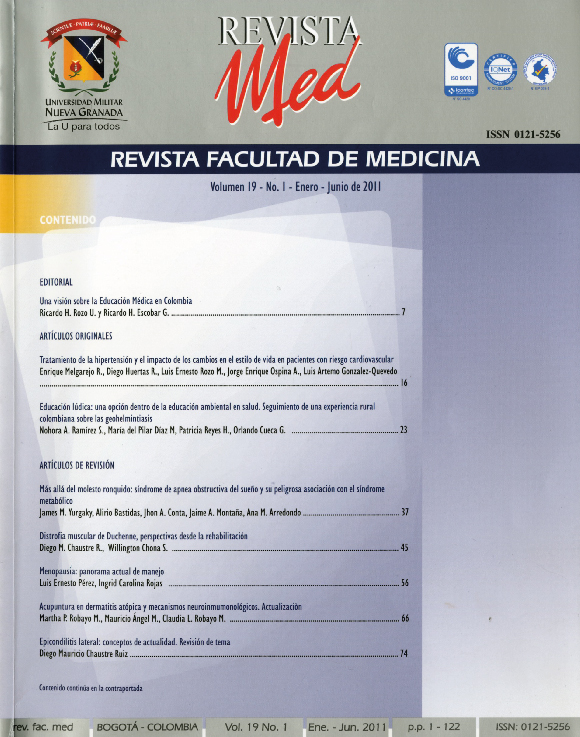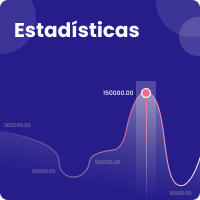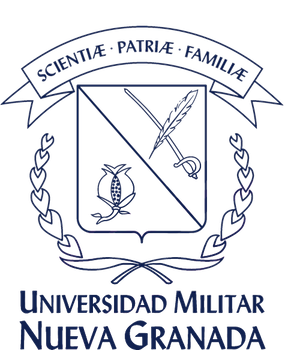Microtúbulos y terapia neural: propuesta de una investigación promisoria
Resumen
La terapia neural es una práctica médica no convencional en la cual se inyectan anestésicos locales (procaína o lidocaína) en concentraciones en un rango de 1 – 10 mg/ml, en cantidades entre 1-10 cm3, en diferentes partes del cuerpo con fines terapéuticos mas no anestésicos. El mecanismo de acción de los anestésicos locales en esta terapia no se conoce. La posible acción remota de la procaína, el efecto de sus propiedades eléctricas en el transporte de señales en el sistema nervioso y en el restablecimiento del potencial fisiológico de membrana son temas centrales de la terapia neural que requieren una interpretación físico-química. En este artículo proponemos que la propagación de señales en microtúbulos neuronales podría estar involucrada en los mecanismos de acción de la procaína en terapia neural. Sugerimos algunos estudios experimentales que conduzcan a una interpretación científica rigurosa de las observaciones reportadas y de los efectos remotos que se atribuyen a la inyección de procaína en terapia neural.
Descargas
Lenguajes:
esReferencias bibliográficas
Hodgkin AL, Huxley AF. A quantitative description of membrane current and its application to conduction and excitation in nerve. J Physiol. 1952;117:500-44.
Becker E, Reed K L. Essentials of local anesthetic pharmacology. Anesth Prog. 2006;53(3):98-108.
Hameroff S, Penrose R. Orchestrated reduction of quantum coherence in brain microtubules: A model for consciousness. Math Comput Simulat .1996;40(3-4):453-80.
Allen D R. El microtúbulo motor intracelular. Investigación y Ciencia. 1987;127:18-25.
Satarić M V, Ilić D I, Ralević N,Tuszynski J A. Nonlinear model of ionic wave propagation along microtubules. Eur Biophys J. 2009;38(5):637-47.
Sataric M V, Tuszynski J A, Zakula R B. Kinklike excitations as an energy-transfer mechanism in microtubules. Phys Rev E Stat Nonlin Soft Matter Phys.1993;48(1):589-97.
Chou K C, Zhang C, Maggiora G. Solitary wave dynamics as a mechanism for explaining the internal motion during microtubule growth. Biopolymer. 1994;34(11):143-53.
Tuszynski J A, Brown J A, Hawrylak P. Dielectric polarization, electrical conduction, information processing and quantum computation in microtubules. Are they plausible? Philos Transact A Math Phys Eng Sci. 1998;356:1877-926.
Lavoie P A, Khazent T, Filion P R. Mechanisms of the inhibition of fast axonal transport by local anesthetics. Neuropharmacology. 1989;28(2):175-81.
Bisby M A. Inhibition of axonal transport in nerves chonically treated with local anesthetics. Exp Neurol. 1975;47:481-9.
Payán J C. Lánzate al vacío y se te extenderán tus alas. Colombia: Mc Graw Hill; 2000.
Torre M R. Terapia neural: ¿defensores o detractores? [en línea]. 2001 [fecha de acceso 2 de noviembre 2010]; VRL Disponible:http://www.amc.sld.cu/amc/2001/v5n2/Terapia_Neural.htm
Dosch P. Libro de la enseñanza de la terapia neural según Huneke: Alemania Heidelberg; 1973.
Fischer L. Terapia neural según Huneke fundamentos técnicas, aplicación práctica. México: Hippokrates; 2006.
Beltrán E. Terapia Neural, Documento Electrónico Aula Virtual grupo académico de medicina alternativa, Universidad Nacional de Colombia. 2009.
Morais A, Gaspar M, Marinho S, Pinto R J. Allergy to local anesthetics of the amide group with tolerance to procaine. Allergy. 2003;58(8):827-8.
Solana J, Morín E. Por un pensamiento complejo: implicaciones interdisciplinarias. Madrid: Akal S.A; 2005.
Maturana H, Varela F. De máquinas e seres vivos. Autopoiese, a Organização do Vivo. Porto Alegre: Artes Médicas, 1997.
Dosch P, Dosch M. Manual of neuratherapy according to Huneke. New York : Thime;2007
Barop H. Atlas de terapia neural. México: Hippokrates Verlag Stuttgart: 2003.
Olivier C, Wenker MD. Review of currently used inhalation anesthetics: Part I J.Anesthesiol.[en línea],1999. [fecha de acceso 14 de noviembre 2010]
Texto online: http://www.ispub.com/ostia/index.php?xmlFilePath=journals/ija/vol3n2/inhal1.xml
Franks N P, Lieb W R. Which molecular targets are most relevant to general anaesthesia? Toxicol Lett .1998;100(101):1-8.
Fang Z X, Sonner J, Laster M J. Anesthetic and convulsant properties of aromatic compounds and cycloalkames: implications for mechanisms of narcosis. Anesth Analg. 1996;83(5):1097-104.
Smerlilli A S. Anestésicos locales: historia, acción farmacológica, mecanismo de acción, estructura química y reacciones adversas. Rev Fac Odontol Univ Buenos Aires. 2004;19(46):19-24.
Yvan A, Ruetsch A, Bönibc T, Alain B. From cocaine to ropivacaine: The history of local anesthetic drugs. Curr Top Med Chem. 2001;1:175-82.
Miyamoto Y, Muto E, Mashimo T, Iwane AH, Yoshiya I, Yanagida T. Direct inhibition of microtubule-based kinesin motility by local anesthetics. Biophys J. 2000;78(2):940-9.
Franks N P, Lieb W R. Do general anesthetics act by competitive binding to specific receptors. Nature. 1984;310:599-601.
Scholz A. Mechanisms of (local) anaesthetics on voltage‐gated sodium and other ion channels. Br J Anaesth. 2002;(89):52-61.
Imbelloni L, Diaz A, Gaspar M, Gouveia A, Cordeiro J. Evaluación de la densidad de los anestésicos locales y de la combinación con adyuvantes. Rev. Bras. Anestesiol. 2009; 59(2):88-93.
Whizar V, Flores J, Puerta G. Toxicidad de los anestésicos locales [en línea], 2002. [fecha de acceso 2 de noviembre 2010] VRL.
Texto online: www.anestesiadolor.org/anestesia/docs/toxicidad_de los_ anestesicos_locales.html
Tucker G T, Mather L. Properties, absortion and disposition of local anesthetics agents: Neural Blockade in clinical anesthesia and management of pain. Philadelphia: Lippincot-Raven; 1998. [fecha de acceso 17 de noviembre 2010].
Texto online: http://www.cookcountyregional.com/Chapter2.pdf
Marcil J, Walczak JS, Guindon J, Ngoc AH, Lu S, Beaulieu P. Antinociceptive effects of tetrodotoxin (TTX) in rodents. Br J Anaesth. 2006;96(6):761-8.
Milos H, Hameroff S, Katheleen M D. Local anesthetics and wound healing. J Surg Res. 1979;27:367-71.
Pierzchalska M, Michalik M, Stepień E, Korohoda W. Changes in morphology of human skin fibroblasts induced by local anaesthetics: role of actomyosin contraction. Eur J Pharmacol. 1998; 358(3):235-44.
Adams H J, Murray R B, Takman B H. The local anesthetic activity of tetrodotoxin alone and in combination with vasoconstrictors and local anesthetics. Anesth analg. 1976;55(4):568-73.
Padera R F, Tse J Y, Bellas E, Kohane D S. Tetrodotoxin for prolonged local anesthesia with minimal myotoxicity. Muscle Nerve. 2006;6(34):743-53.
Hagen N, Du S P, Lapointe B, Ong L M, Dubuc B, Walde D, Love R, Ngoc A H. Tetrodotoxin for moderate to severe cancer pain: a randomized, double blind, parallel design multicenter study. J Pain Symptom Manage. 2008;35(9):420-9.
Covino B, Giddon D. Pharmacology of local anesthesic agents. J Dent Rev. 1981;60:1454-9.
Mandelkow E, Song Y H, Schweers O, Marx A, Mandelkow E M. On the structure of microtubules, tau, and paired helical filaments. Neurobiol Aging. 1995;16(3):347-54.
Zhous J, Giannakakous P. Targeting microtubules for cancer chemotherapy. Curr Med Chem Anti-Cancer Agents. 2005;5:65-71.
Hameroff S, Watt R C. Information processing in microtubules. J Theor Biol. 1982;98:549-61.
Penrose R. Lo grande y lo pequeño de la mente humana. Madrid humana.Madrid: Cambridge; 1999.
Conde C, Cáceres A. Microtubule assembly, organization and dynamics in axons and dendrites. Nat Rev Neurosci. 2009;10:319-31.
Schaap I A, Carrasco C P, MacKintosh J, Frederick C, Christoph F. Elastic response, buckling, and instability of microtubules under radial indentation. Biophys J. 2006;91(4):1521-31.
ayley P, Schilstra M, Martin S A. Lateral cap model of microtubule dynamic instability. FEBS Lett. 1989;259(1):181-4.
Faber J, Portugal R, Rosa L P. Information processing in brain microtubules. Biosystems. 2006;83(1):1-9.
Kamarova Y. Life cycle of MTs: persistent growth in the cell interior, asymmetric transition frequencies and effestts of the cell boundary. J Cell Sci. 2002;115:3527-39.
Insinna E M, Zaborski P, Tuszynski J. Electrodynamics of microtubular motors: the building blocks of a new model. Biosystems. 1996;39(3):187-226.
Cassimeris L. Microtubule assembly: lattice GTP to the rescue. Curr Biol. 2009;19(4):174-6.
Yu W, Baas, P W. Changes in microtubule number and length during axon differentiation. J Neurosci. 1994;14(5):2818-29.
Poulain F E, Sobel A. The microtubule network and neuronal morphogenesis: dynamic and coordinated orchestration through multiple players. Mol Cell Neurosci. 2010;43(1):15-32.
Fourest A, Peris L, Gache V, Garcia I, Juillan B, Lantez V, Job D. Microtubule rgulation in mitosis: Tubulin phosphorylation by the cyclin-dependent kinase Cdk1. Mol Biol Cell. 2006;17(3):1041-50.
Mandelkow E, Mandelkow E M. Microtubules and microtubuleassociated proteins. Curr Opin Biol Cell. 1995;7(1):72-81.
Lahoz R, Hameroff S, Dayhoff J. Connection weights based on molecular mechanisms in Aplysia neuron synapses. Neurocomputing. 1996;11:179-202.
Mark M, Slaughter T, Moshiach S, Obrocka M, Fischer I. Tau is enriched on dynamic microtubules in the distal region of growing axons. J Neurosci. 1996;76(11):3601-19.
Fukada E, Ueda H, Rinaldi R. Piezoelectric and related properties of hydrated collagen. Biophys J. 1976;16(8):911-8.
Fröhlich H. Long range coherence and the actions of enzymes. Nature. 1970;228:1093.
Fröhlich H. Longrange coherence and energy storage in biological. Systems. Int J Quant Chem. 1968;2:6419.
Georgiev D, Papaioanou N, Glazebrook J F. Solitonic effects of the local electromagnetic field on neuronal microtubules. Neuroquantology. 2007;5(3):276-91.
Trpisova B, Tuszynski J A. Possible link between guanosine 5 triphosphate hydrolysis and solitary waves in microtubules. Phys Rev Leett. 1997;53(3):3305-288.
Tuszynski J A, Trpisová B, Sept D, Sataric M V. The enigma of microtubules and their self-organizing behavior in the cytoskeleton. Biosystems. 1997;42(2-3):153-75.
Athenstaedt H, Claussen H. Evidence for pyroelectric and piezoelectric sensory mechanisms in the insect integument. Biophys J. 1981;35:365-74.
Tuszynski J A, Hameroff S, Sataric M, Trpisová V, Nip B. Ferroelectric behavior in microtubule dipole lattices: Implications for information processing, signaling and assembly/disassembly. J Theor Biol. 1995;174(4):371-80.
Roman F, Jaimes R, Osorio Y. Acercamiento al comportamiento dieléctrico de la procaína y sus soluciones: análisis de la permitividad dieléctrica con la procaina. Encuentro Internacional de Terapia Neural; Cuba 2004.
Martínez J, Ávila C, Fayad R. Transporte de señales eléctricas en microtúbulos: una aproximación cuántica. Rev Col Fis. 2010;42(2):104-6.
Hameroff S, Nip A, Porter M, Tuszynski J. Conduction pathways in microtubules, biological quantum computation, and consciousness. Biosystems. 2002;42(64):149-68.
Bókkon I, Salari V, Tuszynski J A, Antal I. Estimation of the number of biophotons involved in the visual perception of single objectimage biophoton intensity can be considerably higher inside cells tan outside. J Photochem Photobiol B. 2010;100(3):100-6.
Amoroso R L. The Production of Frohlich and Bose-EIinstein Coherent States in vitro paracrystaline Oligomers Using Phase control laser Interferometry. Bioelectrochemistry. 1996;41:39-42.
Gauger E, Rieper E, Morton J, Vedral V. Sustained Quantum Coherence and Entanglement in the Avian Compass. Phys Rev Lett. 2011;106(4):4 páginas.
Reimers J R, McKenzie R, Mark A, Hush N. Weak, strong, and coherent regimes of Fröhlich condensation and their applications to terahertz medicine and quantum consciousness. PNAS. 2009;106(11):4219-24.
Payán J C. La desobediencia vital. Buenos Aires: Salbe Ediciones;2005 75. Priel A, Ramos AJ, Tuszynski JA, Cantiello H.F. A biopolymer transistor: electrical amplification by microtubules. Biophys J. 2006;90(12):4639-43.
Priel A, Cantiello H, Tuszynski J A. A nonlinear cable-like model of amplified ionic wave propagation along microtubules. EPL (Europhysics Letters). 2008;83(6)
Etienne-Manneville S. From signaling pathways to microtubule dynamics: the key players . Curr Opin Cell Biol . 2010;22(1):104-11.







.png)





